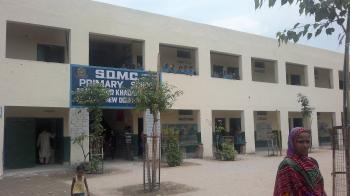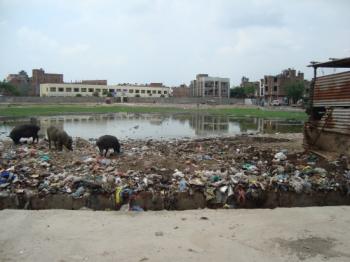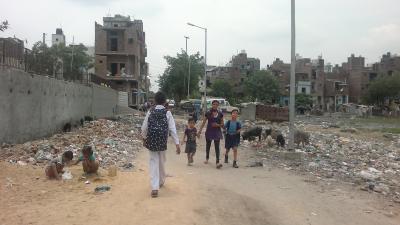A passionate school teacher took the lead in making his school a model in sanitation. However, the ground in front of the school is an open defecation area.
Published on: 16/09/2014
Blog by Ruchika Shiva and Kurian Baby, India Country Programme
This is what we have seen during a recent visit to the government primary school in Madanpur Khadar, a resettlement colony on the periphery of Delhi. The school headmaster, Shamin Ahmed, with the support from a local NGO, CASP Plan (a Program Unit of Plan India), has made tremendous efforts towards improving the water and sanitation conditions in the school, which had very challenging circumstances. The headmaster has been proactive in mobilizing funds to make school toilets functional and water accessible to the children and taught them hygiene practices.

To meet the needs of the increased number of students and double shifts, with the help of the NGO, the school plans to increase the number of toilet seats in the school’s sanitary block. They are also planning to install a biodigester to treat the waste from toilets and use the waste water for irrigating the school garden which will be maintained by children’s groups. The school aims to build a rain water harvesting system to tap and conserve rain water. The headmaster has also introduced hygiene education in the school, which includes the key hygiene messages - hand washing, use of toilets and maintaining hygiene in school by throwing waste (including food from mid-day meal) in garbage bins and rather than throwing it away indiscriminately. Information Education and Communication materials (story books and animation films) are being used to make these messages more effective. The school is on its way to become a model for sanitation and hygiene.

Ironically, while the efforts inside the school are towards a sanitized environment, the school boundary wall on the outside is used by the community members for open defecation. There is a huge patch of land in front of the school, which was intended to be a park, is now being used for dumping household waste and as an open defecation site. Efforts have been made by the school to address this problem. Parents came together and one of them volunteered to monitor the area. Lights were put in to ensure that nobody defecates in the open when it’s dark. To everyone’s great disappointment, within a few days the lights were broken and the volunteer who tried to stop open defecation was beaten up.
Every time it rains this open defecation area gets flooded and the flood water carrying the human and animal excreta, solid and liquid waste flows into the school compound through the front gate, where children assemble for morning prayers and meetings. The clogged waste water remains there as a water loo till it dries up leaving dangerous pathogens on the ground. The local urban body apparently is not worried much, as large infrastructure, and not sanitation which is a constitutional mandate, is their priority!

As the example of this school shows, it is just a drop in the ocean when the local authorities are not cooperating. How will India succeed in achieving coverage for all schools by 2015 this way? Of course we have to start somewhere, but isolated examples like these will not improve the health status of people unless efforts reach a critical mass. All bodies and local authorities must see sanitation as a top priority and push for planning and implementation within their circles of power. Only then will sustainable services at scale be achievable by 2019.
At IRC we have strong opinions and we value honest and frank discussion, so you won't be surprised to hear that not all the opinions on this site represent our official policy.